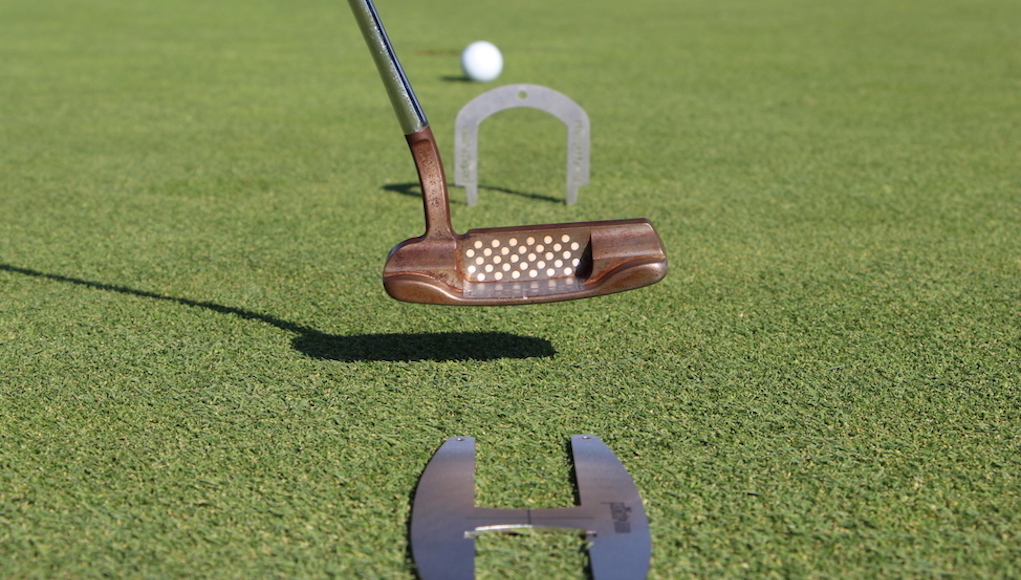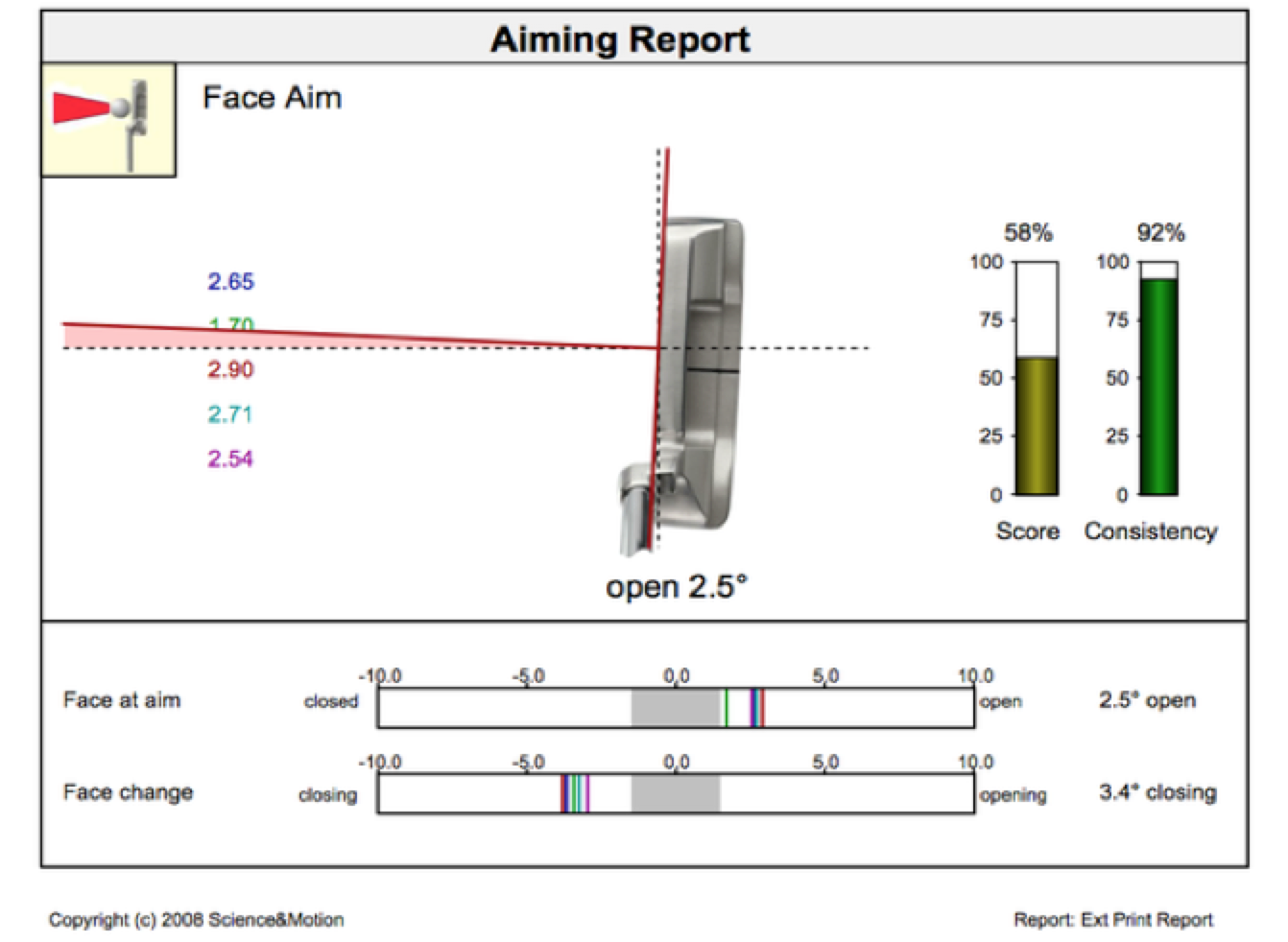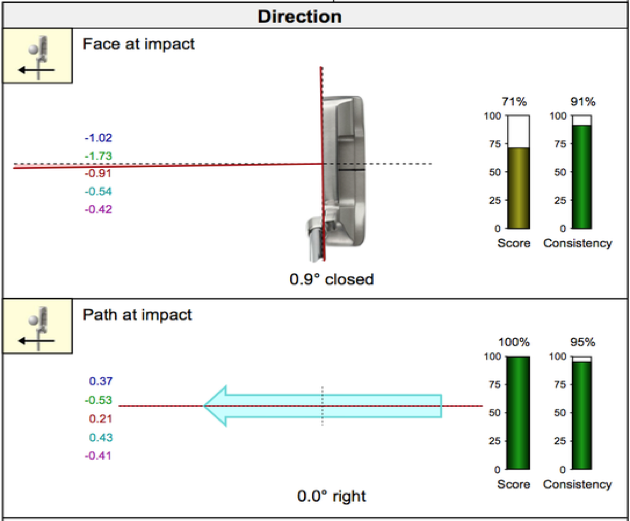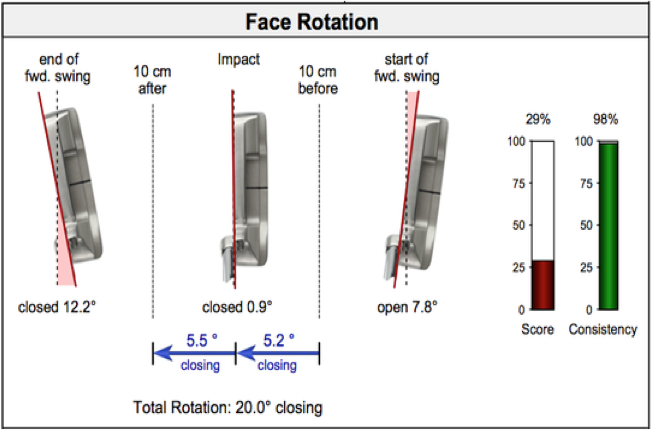Instruction
4 keys to developing a more consistent putting stroke

One of the most important aspects of putting is the repeatability of your stroke. That’s because reading putts perfectly isn’t very helpful unless you can consistently control your speed and direction on the greens.
The average amateur has little control over how the putter moves back and forth, thus they have little consistency in how the ball comes off the blade. The mechanical side of putting is all about getting the ball to leave the putter face exactly where you want it to.
The question is, how can golfers accomplish greater consistency on the green? Below are 4 keys to help you hone the repeatable putting stroke you’ve always wanted.
The Four Keys
- Address Alignment of the Putter Face
- Impact Alignment of the Putter Face
- The Path of the Putter Head
- The Rotation of the Putter Head
Note: Before I begin, I want to make clear that I’m only focusing on the horizontal (side-to-side) launch of the ball, which governs the starting direction of your putt based on your intended line. We’ll assume you have perfect vertical (up-and-down) launch characteristics, which will be the topic of another story.
1) Address Alignment of the Putter Face
It’s nearly impossible to be consistent on the greens if your putter face is aimed away from your target line.
In your practice sessions (on a real putting green or your carpet at home), use visual keys in practice such as putting mirrors, T-squares, chalk lines and lines on the golf ball so you can understand the difference between open, closed and square.
Don’t forget about putter designs! Different players respond differently to certain designs, and finding the right match for you could drastically improve your alignment. Take the time to read what David Edel says about how your alignment changes with different putters.
Also, I highly encourage you to use some kind of putting analysis technology at your closest fitter or instructor that has the technology. It can help you diagnose a problem that you may not even have known existed. I personally recommend SAM Puttlab, an ultrasound machine that measures more than 20 different factors of a putting stroke.
Below is an example of the feedback that SAM Puttlab offers. I have used it in my academies for more than 10 years to give my students a better understanding of their putting motion.

First, note the alignment of the blade at address. You can see that this player has a propensity to line up the face about 2.5-degrees open (to the right) of his intended target. It’s true that many players have issues aiming the putter perfectly at address, which they have to make up for during the stroke by altering their club face or club path into the ball. The more manipulation you have in your stroke, the more you have to rely on your hand/eye coordination to take over for your faulty alignments.
If you’re new to SAM, consult a professional instructor to ensure you’re reading the results properly. Diagnosing your issues is key to developing a plan to improve.
2) Impact Alignment of the Putter Face
The second factor in putting consistency is the ability to return the blade to square at impact. As we saw above, the sample player’s putter was 2.5-degrees open at address, meaning an adjustment had to be made during the stroke to avoid pushing the ball to the right.

Thankfully, this player closed the putter face during the stroke and had a path that was right down the line. Ultimately, his horizontal launch conditions were not skewed, but it’s a move that’s very difficult to repeat consistently. It’s best to start with a square face, and return the face to square at impact.
NOTE: The face angle of the putter at impact accounts for more than 80 percent of a balls starting direction.
3) The Path of the Putter Head
 Putting devices that provide feedback based on starting direction are very effective. The training aid above is from Perfect Putter, which leaves no doubt whether your putt was hit on line or not.
Putting devices that provide feedback based on starting direction are very effective. The training aid above is from Perfect Putter, which leaves no doubt whether your putt was hit on line or not.
I am not so concerned with what your stroke shape looks like (square-to-square or on an arc), but I do care where the ball starts. It’s tough to putt the ball through the gate if you have a face angle or path that isn’t on the intended target line. Remember, if you can align yourself properly at address, you’ll greatly reduce the amount of adjustments needed during the stroke.
4) The Rotation of the Putter Head
The last key is how the putter opens and closes during the stroke. The rate of closing is very important and highly correlated to the type of putter and putting stroke you employ.
 Simply put, if you use more of a square-to-square method, you should gravitate toward a face-balanced putter. The more arc you employ in your stroke, the more you should seek a putter with toe hang. Of course, this is a general rule, but one that works more often than not.
Simply put, if you use more of a square-to-square method, you should gravitate toward a face-balanced putter. The more arc you employ in your stroke, the more you should seek a putter with toe hang. Of course, this is a general rule, but one that works more often than not.
To test the putter you are using, balance the shaft on your index finger and see where the face of the putter points. If it points directly skyward you have a face-balanced putter; if not, you have a toe-hanging putter of some kind.
Getting your stroke diagnosed and finding the right putter can definitely be accomplished during the winter, so no excuses. Plus, you can practice your stroke and alignments while putting in your living room. Happy experimenting!
- LIKE106
- LEGIT12
- WOW3
- LOL1
- IDHT1
- FLOP3
- OB1
- SHANK11
Instruction
Clement: Laid-off or perfect fade? Across-the-line or perfect draw?

Some call the image on the left laid off, but if you are hitting a fade, this could be a perfect backswing for it! Same for across the line for a draw! Stop racking your brain with perceived mistakes and simply match backswing to shot shape!
- LIKE0
- LEGIT0
- WOW0
- LOL0
- IDHT0
- FLOP0
- OB0
- SHANK1
Instruction
The Wedge Guy: The easiest-to-learn golf basic

My golf learning began with this simple fact – if you don’t have a fundamentally sound hold on the golf club, it is practically impossible for your body to execute a fundamentally sound golf swing. I’m still a big believer that the golf swing is much easier to execute if you begin with the proper hold on the club.
As you might imagine, I come into contact with hundreds of golfers of all skill levels. And it is very rare to see a good player with a bad hold on the golf club. There are some exceptions, for sure, but they are very few and very far between, and they typically have beat so many balls with their poor grip that they’ve found a way to work around it.
The reality of biophysics is that the body moves only in certain ways – and the particulars of the way you hold the golf club can totally prevent a sound swing motion that allows the club to release properly through the impact zone. The wonderful thing is that anyone can learn how to put a fundamentally sound hold on the golf club, and you can practice it anywhere your hands are not otherwise engaged, like watching TV or just sitting and relaxing.
Whether you prefer an overlap, interlock or full-finger (not baseball!) grip on the club, the same fundamentals apply. Here are the major grip faults I see most often, in the order of the frequency:
Mis-aligned hands
By this I mean that the palms of the two hands are not parallel to each other. Too many golfers have a weak left hand and strong right, or vice versa. The easiest way to learn how to hold the club with your palms aligned properly is to grip a plain wooden ruler or yardstick. It forces the hands to align properly and shows you how that feels. If you grip and re-grip a yardstick several times, then grip a club, you’ll see that the learning curve is almost immediate.
The position of the grip in the upper/left hand
I also observe many golfers who have the butt of the grip too far into the heel pad of the upper hand (the left hand for right-handed players). It’s amazing how much easier it is to release the club through the ball if even 1/4-1/2″ of the butt is beyond the left heel pad. Try this yourself to see what I mean. Swing the club freely with just your left hand and notice the difference in its release from when you hold it at the end of the grip, versus gripping down even a half inch.
To help you really understand how this works, go to the range and hit shots with your five-iron gripped down a full inch to make the club the same length as your seven-iron. You will probably see an amazing shot shape difference, and likely not see as much distance loss as you would expect.
Too much lower (right) hand on the club
It seems like almost all golfers of 8-10 handicap or higher have the club too far into the palm of the lower hand, because that feels “good” if you are trying to control the path of the clubhead to the ball. But the golf swing is not an effort to hit at the ball – it is a swing of the club. The proper hold on the club has the grip underneath the pad at the base of the fingers. This will likely feel “weak” to you — like you cannot control the club like that. EXACTLY. You should not be trying to control the club with your lower/master hand.
Gripping too tightly
Nearly all golfers hold the club too tightly, which tenses up the forearms and prevents a proper release of the club through impact. In order for the club to move back and through properly, you must feel that the club is controlled by the last three fingers of the upper hand, and the middle two fingers of the lower hand. If you engage your thumbs and forefingers in “holding” the club, the result will almost always be a grip that is too tight. Try this for yourself. Hold the club in your upper hand only, and squeeze firmly with just the last three fingers, with the forefinger and thumb off the club entirely. You have good control, but your forearms are not tense. Then begin to squeeze down with your thumb and forefinger and observe the tensing of the entire forearm. This is the way we are made, so the key to preventing tenseness in the arms is to hold the club very lightly with the “pinchers” — the thumbs and forefingers.
So, those are what I believe are the four fundamentals of a good grip. Anyone can learn them in their home or office very quickly. There is no easier way to improve your ball striking consistency and add distance than giving more attention to the way you hold the golf club.
More from the Wedge Guy
- The Wedge Guy: Golf mastery begins with your wedge game
- The Wedge Guy: Why golf is 20 times harder than brain surgery
- The Wedge Guy: Musings on the golf ball rollback
- LIKE86
- LEGIT13
- WOW6
- LOL1
- IDHT0
- FLOP4
- OB1
- SHANK8
Instruction
Clement: Stop ripping off your swing with this drill!

Not the dreaded headcover under the armpit drill! As if your body is defective and can’t function by itself! Have you seen how incredible the human machine is with all the incredible feats of agility all kinds of athletes are accomplishing? You think your body is so defective (the good Lord is laughing his head off at you) that it needs a headcover tucked under the armpit so you can swing like T-Rex?
- LIKE0
- LEGIT2
- WOW2
- LOL0
- IDHT0
- FLOP0
- OB0
- SHANK2
-

 19th Hole2 weeks ago
19th Hole2 weeks agoDave Portnoy places monstrous outright bet for the 2024 Masters
-

 19th Hole3 days ago
19th Hole3 days agoJustin Thomas on the equipment choice of Scottie Scheffler that he thinks is ‘weird’
-

 19th Hole2 weeks ago
19th Hole2 weeks agoTiger Woods arrives at 2024 Masters equipped with a putter that may surprise you
-

 19th Hole3 days ago
19th Hole3 days ago‘Absolutely crazy’ – Major champ lays into Patrick Cantlay over his decision on final hole of RBC Heritage
-

 19th Hole2 weeks ago
19th Hole2 weeks agoTwo star names reportedly blanked Jon Rahm all week at the Masters
-

 19th Hole1 week ago
19th Hole1 week agoReport: LIV Golf identifies latest star name they hope to sign to breakaway tour
-

 19th Hole1 week ago
19th Hole1 week agoNeal Shipley presser ends in awkward fashion after reporter claims Tiger handed him note on 8th fairway
-

 19th Hole1 week ago
19th Hole1 week agoBrandel Chamblee has ‘no doubt’ who started the McIlroy/LIV rumor and why
















Brendan
Dec 28, 2016 at 6:49 am
Tom what is the name/brand of the alignment tools shown in the photos, looks simple but effective and would fit nicely in the golf bag
kevin
Dec 23, 2016 at 8:24 am
http://www.getthepointgolf.com Face angle and center strikes at impact !! Practice how you play!
Stick
Dec 23, 2016 at 3:51 am
Just use this thing, it’s been mentioned before in the forums
http://www.tru-rollputters.com
Chris
Dec 22, 2016 at 3:50 pm
Help me understand. The article about 4 keys to developing a consistent putting stroke. If I look at your 4 keys, they are more about modifying your stroke to fit theoretical perfection.
Address Alignment of the Putter Face – you indicate that you need to be aimed at the target to be consistent; yet you show a Puttlab report for a person that is pretty consistent in their current setup although open to the target line. Last time I checked, the ball doesn’t know anything about where my putter is pointed at setup. The ball as you stated reacts to your second key which is impact.
Impact Alignment of the Putter Face – You show a player that has nearly perfect path and a putter that pretty much ends up closed at impact. Overall this is a pretty consistent stroke that probably doesn’t need to change. Why do you think the player made an adjustment instead of having a stroke that has a lot of rotation?
The Path of the Putter Head – How often do you find a player that has or can achieve a perfect stroke? You also seem to imply that alignment somehow influences the stroke. How does alignment influence stroke? Do you completely overhaul a players full swing if they have a tendency to align left or right? Why change a persons stroke if teh path is left of right?
The Rotation of the Putter Head – This is the key to everthing you discussed in the article which is finding a putter that matches your stroke. In this diagram while the score isn’t high, the player has very consistent rotation.
The stroke you show with 80% influece of the face at impact is probably a pretty good stroke overall and the person makes a lot of putts. I doubt that the player has any manipulations due to the consistency so why would you advocate the person learn a new setup? Why not as you state in the last section find a putter that has a less rotation that will help the player start the ball online even more consistently. If the player had a stroke that was biased to the left or right; which I would be the overwhelming majority of players do, is it easier to change their stroke or to change their putter?
Stanley
Dec 22, 2016 at 8:38 pm
You can always play with that you have, but everyone is able to change putter path (or more exacty, the swing direction). An positiv angle of attack is preferred with the putter. A lefty motion will move the lowest point more towards the left foot (righthanded) and make the angle of attack more negativ.
A fitted putter would never be able to compensate for a bad movement. The rotation of the putterhead is mostly a result of a grip too much in the fingers and standing to far away from the ball.
Stanley
Dec 22, 2016 at 8:39 pm
You can always play with that you have, but everyone is able to change putter path (or more exacty, the swing direction). An positiv angle of attack is preferred with the putter. A lefty motion will move the lowest point more towards the left foot (righthanded) and make the angle of attack more negativ.
A fitted putter would never be able to compensate for a bad movement. To much rotation in the putterhead is mostly a result of a grip too much in the fingers and standing to far away from the ball.
Chris
Dec 22, 2016 at 10:05 pm
Yes, everyone is able to change putter path, but how long will it take to ingrain the change. Is it better to fit yourself to a putter or a putter to you. If you are suggesting moving closer to the ball and changing grip, you are changing how the person sees the line of the putt and making a significant overhaul in stroke mechanics.
What is your definition of “bad movement”?
The funny thing about the puttlab report that is part of this article is that they are snapshots from Tiger’s Puttlab report in 2010 and I wouldn’t consider him a bad putter or want to change his mechanics.
PinHigh
Dec 22, 2016 at 2:41 pm
Tom’s article is based on simple facts that golfers overlook. Tom thank you for the reminder, that simple. Keep doing what you do and don’t listen to the noise.
Ror
Dec 22, 2016 at 6:04 pm
Noise!!!
4right
Dec 22, 2016 at 6:07 pm
Probably one sad dude to play with… Probably acts like that kid from Duke if things don’t go his way…Hater…
alexdub
Dec 22, 2016 at 11:02 am
Showing some love for the rusted out TeI3 Santa Fe. Such a beautiful putter.